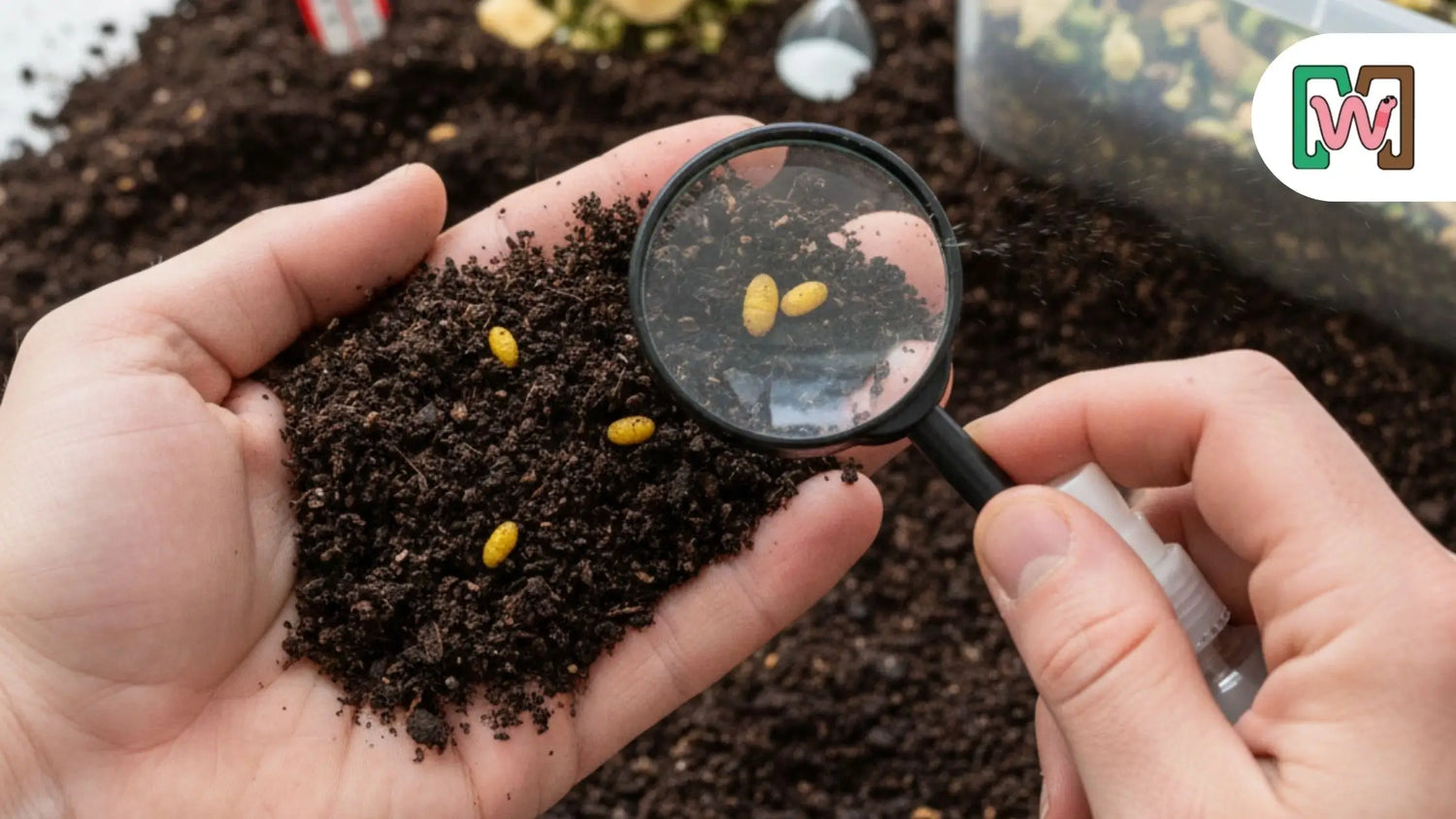What Are Red Wiggler Cocoons?
Before you can hatch them, you need to know what you're looking for! Red wiggler cocoons are often mistaken for seeds or even pest eggs, but they are the beginning of your next generation of composting powerhouses.
- Appearance: They are tiny, about the size of a grape seed, and have a distinctive lemon shape with two tapered ends.
- Color: When first laid, they are a pale, translucent yellow. As the baby worms (or embryos) inside develop, the cocoons turn a rich, reddish-brown color. This color change is a great sign that hatching is imminent!
- Texture: They have a tough, protective casing that feels firm to the touch.
Pro Tip: When sifting through your worm bin, look for these little "lemons" in the moist bedding, often clustered near a food source. Handle them gently—their casing is durable, but the life inside is delicate.

The Red Wiggler Lifecycle Timeline: What to Expect
Patience is key in vermicomposting! Understanding the timeline from cocoon to adult worm will help you monitor your progress without worry.
Here’s a simple breakdown of the red wiggler lifecycle:
- Cocoon Stage: After being laid, the cocoon incubates for about 23 to 30 days under ideal conditions (moist, 70-80°F).
- Hatching: The baby worms, called "hatchlings," emerge. They are incredibly tiny—only about 1 cm long—and are a whitish, almost translucent color when they first hatch. Within a day or two, they develop their characteristic red hue.
- Maturation: These baby worms will grow rapidly with plenty of food, reaching maturity in about 4 to 6 weeks. Once mature, they will begin producing their own cocoons, and the cycle continues!
Remember: This timeline is dependent on the conditions you create. Cooler temperatures can slow the process, while perfect conditions can sometimes lead to a slightly faster hatch.
Must Read : What Are The Different Types of Nightcrawler Worms?

Top 5 Tips to Hatching Red Wiggler Cocoons
If you're passionate about creating a thriving garden while reducing waste, red wiggler cocoons can be your secret weapon. These tiny, unassuming capsules hold the key to producing a colony of red wigglers that can transform food scraps into nutrient-rich compost for your soil. However, hatching red wiggler cocoons requires the right conditions and care. Here are the top five tips to boost your success and improve hatch rates for your red wiggler cocoons
Tip # 1: Maintain Proper Moisture Levels for Worm Cocoons to Hatch.
Moisture is critical for hatching red wiggler cocoons, as it keeps the embryos hydrated and supports development. Ideal moisture levels should be around 85-90%, but without standing water.
- If you're in a dry climate, use a humidifier in the room where you store the cocoons.
- Cover the cocoons with a damp cloth, paper towel, or bubble wrap (bubble side down) to retain moisture while allowing airflow.
- Check daily to ensure the covering remains damp but not soggy.
Proper hydration creates a nurturing environment for your cocoons to hatch successfully.
Tip #2: Provide Complete Darkness For Cocoons.
Darkness is essential for red wiggler cocoons to hatch. Exposure to light can hinder the delicate transformation process.
- Store cocoons in a dark place, such as a closet, cabinet, or under a piece of cardboard.
-
Avoid direct sunlight by adding a layer of dark plastic, carpet, or other opaque coverings.
By mimicking their natural, shaded environment, you give the cocoons the best chance to thrive.
Tip #3: Monitor Compost Temperature Closely
Temperature plays a crucial role in the hatching process. The optimal range for red wiggler cocoons is between 70-80°F.
- If your space is too cold, use a heating pad or heat mat with temperature controls.
- Position the cocoons near a consistent heat source, such as a radiator, to maintain warmth.
- We recommend using heat mats like the Vivosun brand to keep the environment stable during colder months.
- Keeping the temperature in the right range ensures your cocoons stay active and viable.
Tip #4: Incubate Your Red Wiggler Cocoons
Incubation provides a controlled environment to maximize hatching rates. Here's how to set up an incubation system for red wiggler cocoons.
- Use a large Styrofoam cooler with shredded paper, damp soil, or other breathable substrate materials.
- Spread cocoons evenly to prevent overlapping, ensuring plenty of airflow.
- Add moisture sources, like damp sponges or wet cotton balls, to keep humidity consistent.
-
Store the cooler in a warm, stable location, checking periodically to maintain the right conditions.
In a few weeks, your red wiggler cocoons will hatch, and you'll have a thriving worm population ready to boost your composting system.
Tip #5: Offer Nutritious Food for Baby Red Wigglers
Once your red wiggler cocoons hatch, the tiny worms will need a readily available food source. Providing the right materials can ensure their survival and growth.
- Manures, such as aged cow or horse manure, are an excellent option because they serve as both bedding and food.
- For an extra boost, add apple slices to the cocoon bins. Apples are rich in sugars and amino acids, which attract and nourish baby red wigglers.
- This nutrient-rich environment helps the emerging worms thrive, supporting their role in your vermicomposting system.
Must Read : How Do Worms Reproduce?
Troubleshooting: Why Aren't My Cocoons Hatching?
You’ve followed the tips, but weeks have passed with no signs of life? Don't give up! Here are the most common reasons cocoons fail to hatch and how to fix them.
Problem: The bin is too dry.
- Signs: Bedding is dusty, cocoons look shriveled.
- Solution: Gently mist the bedding with water and mix thoroughly. Use the "wrung-out sponge" test—it should feel moist but not drip water.
Problem: The bin is too acidic.
- Signs: A sour smell, presence of fruit flies, or white mites.
- Solution: Avoid feeding citrus, onions, and garlic. Add a handful of crushed eggshells or a scoop of garden lime (calcium carbonate) to neutralize the pH.
Problem: The temperature is too extreme.
- Signs: Bin is feeling very cold or hot to the touch.
- Solution: Move the bin to a more temperature-stable area. In hot climates, ensure it's in the shade. In cold climates, a heating mat on a low setting can work wonders.
Problem: Cocoons are buried too deep without air.
- Signs: Bedding is compacted and soggy.
- Solution: Gently fluff the bedding to introduce oxygen. Ensure your incubation setup isn't airtight.
Must Read : Which are the Best Worms for Fishing? Lets Find Out
Your First Steps After the Hatch: Caring for Baby Wigglers
Congratulations, your cocoons have hatched! Now, how do you care for these tiny new arrivals? Their needs are slightly different from adult worms.
- Food: Hatchlings have tiny mouths. Stick to soft, easy-to-eat foods like mashed avocado, overripe banana, or pumpkin puree. Avoid coarse or acidic foods.
- Bedding: Ensure the bedding is finely shredded and soft. Shredded cardboard or coconut coir is perfect. The babies will actually consume this bedding as they grow.
- Safety: The single biggest threat to baby worms is overfeeding. Uneaten food will rot and create toxic conditions. Start with a tablespoon of food and only add more once it's mostly gone.
- Patience: Let them grow! Within a few weeks, they will be robust enough to join your main worm bin and handle a normal diet.

Hatching Cocoons vs. Starting with Adult Worms
Are you wondering if starting with cocoons is even the right choice for you? Here’s a quick breakdown to help you decide.
| Factor | Hatching Cocoons | Starting with Adult Worms |
|---|---|---|
| Cost | ✅ Much Lower Cost - Cocoons are significantly cheaper than the same number of adult worms. | ❌ Higher Initial Cost |
| Time to Composting | ❌ Slower - You'll need to wait 2+ months for a sizable, compost-processing population. | ✅ Immediate - Adults can start processing scraps right away. |
| Shipping Stress | ✅ Very Resilient - Cocoons are tough and ship extremely well with no risk of escaping. | ❌ Sensitive - Live worms can suffer from heat, cold, or delays in transit. |
| Educational Value | ✅ Incredibly Rewarding - Watching the entire lifecycle is a fantastic learning experience. | ❌ Standard - You miss the wonder of the early life stages. |
| Population Boom | ✅ Exponential Growth - You start small but can quickly grow a large, localized population. | ❌ Linear Growth - You'll have to wait for the existing adults to breed. |
The Verdict: Choose cocoons for cost-effectiveness and a rewarding project. Choose adult worms if you want to start vermicomposting immediately.
Get Started with Your Red Wiggler Cocoons Today!
With these tips, you're ready to hatch your red wiggler cocoons and build a robust worm population. All you need are quality cocoons, a bit of patience, and dedication to creating the right conditions. Remember, every successful hatch brings you closer to an eco-friendly composting system that benefits your garden and the planet.
Purchase your red wiggler cocoons from a trusted supplier, and don't hesitate to experiment and refine your process. With time and effort, you'll become a pro at hatching these incredible worms and enjoy the benefits they bring to your gardening journey!



2 comments
Tom
LeRoy, That would dépend on your location. In my San Jose yard it is too hot and DRY for earthworms to thrive. You can test by digging a hole in the local field or forest to see how many worms you find.
In the ground added worms are food for lots of predators!
It would be better to start a worm bin. In a bin the worms are the alpha predator. They eat and multiply and they poop. Add that worm poop (vermicompost) to your yard. I spread worm poop onto my tired old front yard and it boomed. I overheard admiring comments as the neighbors walked by. Try it?
LeRoy Rendon
We bought a house less than a year ago. The builder brought in sand and put down centipede grass for the lawn. Would it be beneficial to purchase earthworms and put them throughout the lawn as a means to enrich the soil?
Leave a comment
All comments are moderated before being published.
This site is protected by hCaptcha and the hCaptcha Privacy Policy and Terms of Service apply.